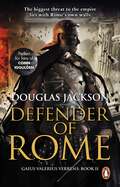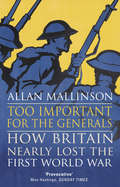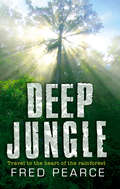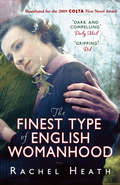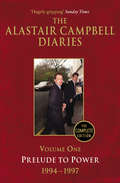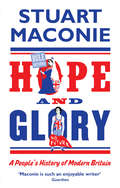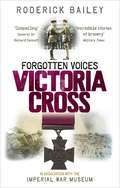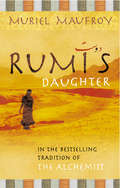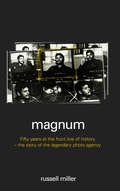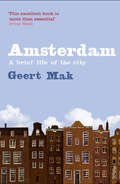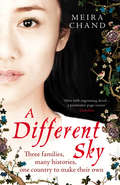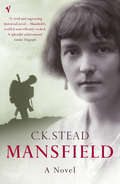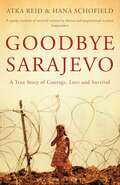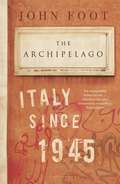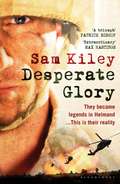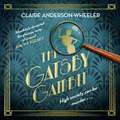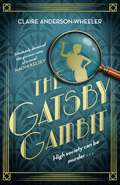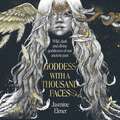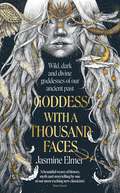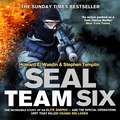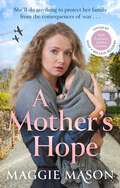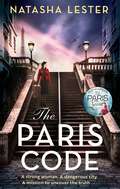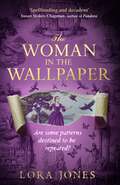- Table View
- List View
Defender of Rome: (Gaius Valerius Verrens 2): A heart-stopping and gripping novel of Roman adventure (Gaius Valerius Verrens #2)
by Douglas JacksonThis riveting and action-packed historical thriller from bestselling author Douglas Jackson is real edge of your seat stuff! Perfect for fans of Simon Scarrow and Ben Kane.Readers are loving Gaius Valerius Verrens! "Absolutely incredible." - 5 STARS."Gripping, violent and captivating." - 5 STARS."The best Roman historical series I've yet read. Just pips Ben Kane and Conn Iggulden." - 5 STARS **************************************************************Gaius Valerius Verrens returns to Rome from the successful campaign against Boudicca in Britain. But he is not the man he once was - scarred both physically and emotionally by the battles he has fought. And neither is Rome the same city as the one he left.The Emperor Nero grows increasingly paranoid. There is talk of a new threat, one found within the walls of Rome itself. A new religious sect, the followers of Christus, deny Nero's divinity and are rumoured to be spreading sedition.Nero calls on Valerius to seek out this rebel sect and to capture their leader. Failure would be to forfeit his life, and the lives of twenty thousand Judaeans living in Rome. But as Valerius begins his search, a quest which will take him to the edge of the empire, he will discover that success may cost him nearly as much as failure.Gaius Valerius Verrens's adventures continue in Avenger of Rome.
Too Important for the Generals: Losing and Winning the First World War
by Allan Mallinson‘War is too important to be left to the generals’ snapped future French prime minister Georges Clemenceau on learning of yet another bloody and futile offensive on the Western Front. One of the great questions in the ongoing discussions and debate about the First World War is why did winning take so long and exact so appalling a human cost? After all this was a fight that, we were told, would be over by Christmas. Now, in his major new history, Allan Mallinson, former professional soldier and author of the acclaimed 1914: Fight the Good Fight, provides answers that are disturbing as well as controversial, and have a contemporary resonance. He disputes the growing consensus among historians that British generals were not to blame for the losses and setbacks in the ‘war to end all wars’ – that, given the magnitude of their task, they did as well anyone could have. He takes issue with the popular view that the ‘amateur’ opinions on strategy of politicians such as Lloyd George and, especially, Winston Churchill, prolonged the war and increased the death toll. On the contrary, he argues, even before the war began Churchill had a far more realistic, intelligent and humane grasp of strategy than any of the admirals or generals, while very few senior officers – including Sir Douglas Haig – were up to the intellectual challenge of waging war on this scale. And he repudiates the received notion that Churchill’s stature as a wartime prime minister after 1940 owes much to the lessons he learned from his First World War ‘mistakes’ – notably the Dardanelles campaign – maintaining that in fact Churchill’s achievement in the Second World War owes much to the thwarting of his better strategic judgement by the ‘professionals’ in the First – and his determination that this would not be repeated.Mallinson argues that from day one of the war Britain was wrong-footed by absurdly faulty French military doctrine and paid, as a result, an unnecessarily high price in casualties. He shows that Lloyd George understood only too well the catastrophically dysfunctional condition of military policy-making and struggled against the weight of military opposition to fix it. And he asserts that both the British and the French failed to appreciate what the Americans’ contribution to victory could be – and, after the war, to acknowledge fully what it had actually been.
Deep Jungle: Journey To The Heart Of The Rainforest
by Fred PearceDEEP JUNGLE is an exploration of the most alien and feared habitat on Earth. Starting with man's earliest recorded adventures, Fred Pearce journeys high into the canopy - home to two-thirds of all the creatures on our planet, many of whom never come down to earth. During his travels he encounters all manner of fantastic flora and fauna, including a frog that can glide from tree to tree, a spider that can drag live chickens into its burrow and a flower that smells of decaying flesh.It is in the jungle that Pearce discovers secrets about how evolution works, the intricate links that connect us all, and maybe even clues to where humans came from - here is the key to our future foods and medicines, our climate and our understanding of how life works. At the start of a new millennium Pearce asks why we continue to waste precious time - and billions of dollars - looking for signs of life elsewhere in our universe when the greatest range of life-forms that have ever existed lies right here on our doorstep. Today environmentalists say we are on the verge of destroying the last rainforests, and with them the planet's evolutionary crucible, and maybe even its ability to maintain life on Earth. But nature has a way of getting its own back. The Mayans and the people of Angkor went too far in manipulating nature and paid the ultimate price. Their civilisations died and the jungle returned. Nature reclaimed it's own and it may do so again ...
The Finest Type of English Womanhood
by Rachel HeathIt is 1946, and seventeen-year-old Laura Telling is stagnating in her dilapidated Sussex family home, while her eccentric parents slip further into isolation. A chance encounter with Paul Lovell offers her the chance to alter the course of her destiny - and to embark on a new life in South Africa. Many miles north, sixteen-year-old Gay Gibson is desperate to escape Birkenhead. When the girls' paths cross in Johannesburg, Laura is exposed to Gay's wild life of parties and inappropriate liaisons. Each in their own worlds, but thrown together, the girls find their lives inextricably entangled, with fatal consequences...
Diaries Volume One: Prelude to Power (The Alastair Campbell Diaries #1)
by Alastair CampbellAs Alastair Campbell said in the introduction to The Blair Years, it was always his intention to publish the full version, covering his time as spokesman and chief strategist to Tony Blair. Prelude to Power is the first of four volumes, and covers the early days of New Labour, culminating in their victory at the polls in 1997.Volume 1 details the extraordinary tensions between Tony Blair and Gordon Brown as they resolved the question as to which one should stand to become Labour leader. It shows that right from the start, relations at the top were prone to enormous strain, suspicions and accusations of betrayal. Yet it also shows the political and personal bonds that tied them together, and which made them one of the most feared and respected electoral machines anywhere in the world. A story of politics in the raw, Prelude to Power is above all an intimate, detailed portrait of the people who have done so much to shape modern history.
Hope and Glory: A People’s History of Modern Britain
by Stuart MaconieIn Hope and Glory Stuart Maconie goes in search of the days that shaped the Britain we live in today. Taking one event from each decade of the 20th century, he visits the places where history happened and still echoes down the years. Stuart goes to Orgreave and Windsor, Wembley and Wootton Bassett, assembling a unique cast of Britons from Sir Edmund Hillary to Sid Vicious along the way.It’s quite a trip, full of sex and violence and the occasional scone and jigsaw. From pop stars to politicians, Suffragettes to punks, this is a journey around Britain in search of who we are.
Forgotten Voices of the Victoria Cross
by The Imperial War Museum Roderick Bailey'It wasn't until after he was safely back in the aircraft again that I heard that he'd actually been out on the wing to try to put the fire out ... Remember that we were flying at about 90 miles an hour at a height of 13,000 feet'Squadron Leader RP Widdowson on Sergeant James Ward, who earned his VC in 1941 The Victoria Cross, awarded to the most courageous and determined servicemen, is the highest military decoration that can be bestowed.In Forgotten Voices: Victoria Cross, first-hand accounts of soldiers, sailors and airmen describe the incredible events that earned these extraordinary men the VC in the last century.Captivating and often humbling, these stories depict exceptional acts of bravery in unimaginable situations, of men who would say they were just doing their duty.Introduction by General Sir Richard Dannatt.
Rumi's Daughter
by Muriel MaufroyRumi is now acknowledged as one of the great mystical poets of the Western world, with huge sales of the many collections of his poetry. Not much is known about his life except that he lived in thirteenth-century Anatolia (now Turkey), had a great spiritual friendship with a wild man called Shams, brought an adopted daughter into his family, and was distraught when Shams finally disappeared. Rumi's Daughter is the delightful novel about Kimya, the girl who was sent from her rural village to live in Rumi's home. She already had mystical tendencies, and learned a great deal under Rumi's tutelage. Eventually she married Shams, an unusual husband, almost totally absorbed by his longings for God. Their marriage was fiery and different and, in the end, dissolved by Kimya's death - after which Shams vanished. Rumi's Daughter tells Kimya's story with great charm and tenderness. Well written and thought-provoking, it is sure to draw comparison with Paolho Coelho's The Alchemist, and also to add something fresh and new to what is so far known about Rumi.
Magnum: Fifty Years at the Front Line of History
by Russell MillerThis book is a biography of Magnum, told largely in the words of its photographers. It offers a unique perspective on half a century of world history from an extraordinary group of men and women who were front line witnesses at virtually every major event in the last fifty years. Wars, famines, natural disasters, social, political and environmental crises - Magnum photographers were there. They have been acute observers of the human condition, photographing the richest people in the world, the poorest, the least known and the most celebrated, from Marilyn Monroe to Che Guevara, JFK to Nelson Mandela, Picasso to Krushchev. This is a multi-layered story. At one level, it tells how a small group of photographrs - among them Robert Capa, Henri Cartier-Bresson and George Rodger - came together, established and nurtured a co-operative photographic agency that has survived against all the odds to become the most famous in the world. At a secondary level, it is the richly anecdotal story of the photographers themselves, their adventures around the world and their feelings about, and reactions to, their assignments.
Amsterdam: A brief life of the city
by Geert MakA magnet for trade and travellers from all over the world, stylish, cosmopolitan Amsterdam is a city of dreams and nightmares, of grand civic architecture and legendary beauty, but also of civil wars, bloody religious purges, and the tragedy of Anne Frank. In this fascinating examination of the city's soul, part history, part travel guide, Geert Mak imaginatively recreates the lives of the early Amsterdammers, and traces Amsterdam's progress from waterlogged settlement to a major financial centre and thriving modern metropolis
A Different Sky
by Meira ChandSingapore - a trading post where different lives jostle and mix. It is 1927, and three young people are starting to question whether this inbetween island can ever truly be their home. Mei Lan comes from a famous Chinese dynasty but yearns to free herself from its stifling traditions; ten-year-old Howard seethes at the indignities heaped on his fellow Eurasians by the colonial British; Raj, fresh off the boat from India, wants only to work hard and become a successful businessman. As the years pass, and the Second World War sweeps through the east, with the Japanese occupying Singapore, the three are thrown together in unexpected ways, and tested to breaking point.Richly evocative, A Different Sky paints a scintillating panorama of thirty tumultuous years in Singapore's history through the passions and struggles of characters the reader will find it hard to forget.
Mansfield: A Novel
by C. K. Stead'A vivid and engrossing historical novel' Daily TelegraphSpanning three years in the life of the writer Katherine Mansfield during the First World War, Mansfield follows the ups and downs of her relationship with Jack Middleton Murry and her struggle to write the 'new kind of fiction' which she felt the times demanded. She is restless, constantly on the move, in and out of London, to and from France, even into the war zone, to be with her French lover, novelist Francis Carco.For a short time, Mansfield is able to behave as though the war is merely 'background', but her ardent relationship with her brother, who arrives from New Zealand to fight in France, makes detachment impossible - as does her love for Jack's Oxford friend Frederick Goodyear, also a soldier. The war's shadow remorselessly darkens all their lives, but only increases Mansfield's determination to break through as a writer.Mansfield is a sharp, subtle and appealing portrait of the person of whose work Virginia Woolf wrote: "It was the only writing I was ever jealous of."
Goodbye Sarajevo: A True Story of Courage, Love and Survival
by Atka Reid Hana SchofieldMay 1992. Hana is twelve years old when her older sister Atka puts her on a UN evacuation bus to flee the besieged city of Sarajevo. Thinking they will be apart for a short time, they make a promise to each other to be brave. But as the Bosnian war escalates and months go by without contact, their promise becomes deeply significant. Hana is forced to cope as a refugee in Croatia, while Atka and their younger siblings battle for survival in a city overwhelmed by crime and destruction. Then, when Atka manages to find work as a translator, events take an unexpected turn, and the remarkable events that follow change her life, and those of her family, forever.
The Archipelago: Italy Since 1945
by John FootIn The Archipelago, acclaimed historian John Foot chronicles Italy's tumultuous history from the post-war period to the present. From the silent assimilation of fascists into society after 1945 to the troubling reign of Silvio Berlusconi, and from the artistic peak of neorealist cinema to the celebration of Italy's 150th birthday in 2011, he examines both the corrupt and celebrated sides of the country. <p><p> While often portrayed as a failed state on the margins of Europe, Italy has instead been at the centre of innovation and change – a political laboratory. Through stories of trials, TV programmes, songs and football matches, moments of violence and beauty, epochal social transformation and suffocating continuities, this new history tells the fascinating story of a country always marked by scandal but with the constant ability to re-invent itself. <p> Comprising original research and lively insights, The Archipelago chronicles the crises and modernisations of over seventy years of post-war Italy, from its fields, factories, squares and housing estates to the political intrigue of Rome.
Desperate Glory: At War in Helmand with Britain's 16 Air Assault Brigade
by Sam KileyIn the dust and blazing heat of Helmand, the young men of 16 Air Assault Brigade find themselves in the most relentless battles faced by British troops in recent history. As the only writer to have obtained unprecedented, unrestricted access to the front line, Sam Kiley is with them to bear witness to the most intense challenges of their lives. It is an unflinching portrait of the reality of war-the bombs, the shooting and the daily struggles that push them to the very limit of human endurance.
The Gatsby Gambit: A completely unputdownable golden age murder mystery
by Claire Anderson-Wheeler'A thoroughly enjoyable mystery story with all the tropes and pleasures of a golden age detective story' Observer'A glamorous recipe of F. Scott Fitzgerald and Agatha Christie' Paula Sutton'Imbued with luxury and lurking danger' S.J. Bennett'Murderously fun' Jessica Bull1922: You are cordially invited to summer at the Gatsby Mansion in West Egg, with the most illustrious - and the deadliest - guest list.Freshly twenty-one and sporting a daring new bob, Greta Gatsby - younger sister to the infamous Jay - is finally free of finishing school. An idyllic summer stretches ahead of her at the Gatsby Mansion, the jewel of West Egg.But when Greta arrives at the secluded white-stone estate bathed in the late-afternoon light, she finds she isn't the only visitor. Jay is hosting an intimate gathering of New York's fashionable set: Daisy and Tom Buchanan, along with his brother Edgar, Nick Carraway and Jordan Baker.That evening, the guests enjoy a candelabra-lit dinner party. That night, they dance to the lilt of the gramophone. The next morning, one of them is missing.Murder has come to West Egg, the warm breeze tainted by scandal, betrayal and secrets. Turning sleuth isn't how Greta meant to spend her summer - but what choice does she have when one of them could be next?The gilded opulence of the Roaring Twenties. A murder that scandalises high society. And a clever young woman of unusual persistence . . . A deliciously unputdownable whodunnit perfect for fans of The Christie Affair and Miss Austen Investigates.'Compelling and bursting with 1920s flair, this new twist on the iconic tale will delight newcomers and old fans alike' CE McGill, author of Our Hideous Progeny'Absolutely devoured this glorious romp of a novel. The Gatsby Gambit is pure escapist fun - a pacy, clever, witty mystery that I galloped through with sheer delight' Naomi Kelsey, author of The Burnings'A glamour-filled, thrilling read that kept me guessing to the end! It was such a treat to be back in the world of Gatsby!' Kate Weston, author of You May Now Kill the Bride'Claire Anderson-Wheeler brilliantly intertwines the allure of the Jazz Age with a gripping murder mystery in The Gatsby Gambit. A dazzling homage to Fitzgerald's world, this novel captivates from the first page to the last' Joanna Wallace, author of You'd Look Better as a Ghost'Lively, smart, and fun . . . As charming as Daisy Buchanan herself' Flynn Berry, author of Northern Spy'With a fiercely defiant female lead and secrets as sharp as the prose, The Gatsby Gambit oozes glamour and intrigue. I loved this bold take on a beloved classic' Trisha Sakhlecha, author of The Inheritance
The Gatsby Gambit: A completely unputdownable golden age murder mystery
by Claire Anderson-Wheeler'A thoroughly enjoyable mystery story with all the tropes and pleasures of a golden age detective story' Observer'A glamorous recipe of F. Scott Fitzgerald and Agatha Christie' Paula Sutton'Imbued with luxury and lurking danger' S.J. Bennett'Murderously fun' Jessica Bull1922: You are cordially invited to summer at the Gatsby Mansion in West Egg, with the most illustrious - and the deadliest - guest list.Freshly twenty-one and sporting a daring new bob, Greta Gatsby - younger sister to the infamous Jay - is finally free of finishing school. An idyllic summer stretches ahead of her at the Gatsby Mansion, the jewel of West Egg.But when Greta arrives at the secluded white-stone estate bathed in the late-afternoon light, she finds she isn't the only visitor. Jay is hosting an intimate gathering of New York's fashionable set: Daisy and Tom Buchanan, along with his brother Edgar, Nick Carraway and Jordan Baker.That evening, the guests enjoy a candelabra-lit dinner party. That night, they dance to the lilt of the gramophone. The next morning, one of them is missing.Murder has come to West Egg, the warm breeze tainted by scandal, betrayal and secrets. Turning sleuth isn't how Greta meant to spend her summer - but what choice does she have when one of them could be next?The gilded opulence of the Roaring Twenties. A murder that scandalises high society. And a clever young woman of unusual persistence . . . A deliciously unputdownable whodunnit perfect for fans of The Christie Affair and Miss Austen Investigates.'Compelling and bursting with 1920s flair, this new twist on the iconic tale will delight newcomers and old fans alike' CE McGill, author of Our Hideous Progeny'Absolutely devoured this glorious romp of a novel. The Gatsby Gambit is pure escapist fun - a pacy, clever, witty mystery that I galloped through with sheer delight' Naomi Kelsey, author of The Burnings'A glamour-filled, thrilling read that kept me guessing to the end! It was such a treat to be back in the world of Gatsby!' Kate Weston, author of You May Now Kill the Bride'Claire Anderson-Wheeler brilliantly intertwines the allure of the Jazz Age with a gripping murder mystery in The Gatsby Gambit. A dazzling homage to Fitzgerald's world, this novel captivates from the first page to the last' Joanna Wallace, author of You'd Look Better as a Ghost'Lively, smart, and fun . . . As charming as Daisy Buchanan herself' Flynn Berry, author of Northern Spy'With a fiercely defiant female lead and secrets as sharp as the prose, The Gatsby Gambit oozes glamour and intrigue. I loved this bold take on a beloved classic' Trisha Sakhlecha, author of The Inheritance
Goddess with a Thousand Faces: A one-of-a-kind exploration of goddesses from our ancient past
by Jasmine Elmer'I loved Goddess with a Thousand Faces. Fascinating, fun and thoughtful and enlightening' JENNIFER SAINT'A beautiful weave of history, myth and storytelling by one of our most exciting new classicists' DAN SNOWSteeped in ancient magic, dark divinity and wild ways, Goddess with a Thousand Faces takes you on a historical journey like no other...Blending mythological retellings with historical research, Goddess with a Thousand Faces traverses the world and transports through time to bring ten formidable and inspiring ancient goddesses to life. Meet Artemis, the Greek goddess of the wilderness, never without her bow and arrow; Sedna, Inuit goddess of the ocean, guarding the icy waters and all its creatures; Isis, Egyptian goddess of healing, who dwells by the River Nile, just to name a few...Jasmine Elmer explores these goddesses of our past, uncovering their truths, their rebellion and their freedom. For too long, they have been written out of history; lost to the sands of time and stamped into silence. Goddess with a Thousand Faces restores these women to their glory. Pour over this treasure trove of myths, legends and mighty goddesses. Hear the messages echoing through the ages and see yourself in the faces of these icons. For while their stories might ancient, today they are more important - and more powerful - than ever.A treasure trove of beautiful storytelling and ancient wisdom, perfect for fans of Love in Colour by Bolu Babalola and Storyland by Amy Jeffs.'Gorgeous. Jasmine Elmer has a fierce passion for these women, and this shines through in her writing. Come for the goddesses, stay for the spiritual journey!' Lizzy Tiffin, author of Bad Girls of Ancient Greece'If you love history and feminist retellings, this is your next must-read. Goddess With a Thousand Faces is a thrilling exploration of lesser-known goddesses from around the world - offering a crash course in feminine myth and worship, with all its power, fury and wonder. I adored it' Rachel Blackmore, author of Costanza'A passionate ode to the inner goddess within us all, that blends a rich and vibrant introduction to a diverse array of cultures and mythologies with accessible retellings. Part mythical guide, part history compendium and part self-help handbook, Jasmine Elmer's sparkling debut offers up a refreshing, inclusive and powerfully feminist manifesto for what it means to be a goddess, ancient and modern' Emily Hauser, author of Mythica
Goddess with a Thousand Faces: A one-of-a-kind exploration of goddesses from our ancient past
by Jasmine Elmer'I loved Goddess with a Thousand Faces. Fascinating, fun and thoughtful and enlightening' JENNIFER SAINT'A beautiful weave of history, myth and storytelling by one of our most exciting new classicists' DAN SNOWSteeped in ancient magic, dark divinity and wild ways, Goddess with a Thousand Faces takes you on a historical journey like no other...Blending mythological retellings with historical research, Goddess with a Thousand Faces traverses the world and transports through time to bring ten formidable and inspiring ancient goddesses to life. Meet Artemis, the Greek goddess of the wilderness, never without her bow and arrow; Sedna, Inuit goddess of the ocean, guarding the icy waters and all its creatures; Isis, Egyptian goddess of healing, who dwells by the River Nile, just to name a few...Jasmine Elmer explores these goddesses of our past, uncovering their truths, their rebellion and their freedom. For too long, they have been written out of history; lost to the sands of time and stamped into silence. Goddess with a Thousand Faces restores these women to their glory. Pour over this treasure trove of myths, legends and mighty goddesses. Hear the messages echoing through the ages and see yourself in the faces of these icons. For while their stories might ancient, today they are more important - and more powerful - than ever.A treasure trove of beautiful storytelling and ancient wisdom, perfect for fans of Love in Colour by Bolu Babalola and Storyland by Amy Jeffs.'Gorgeous. Jasmine Elmer has a fierce passion for these women, and this shines through in her writing. Come for the goddesses, stay for the spiritual journey!' Lizzy Tiffin, author of Bad Girls of Ancient Greece'If you love history and feminist retellings, this is your next must-read. Goddess With a Thousand Faces is a thrilling exploration of lesser-known goddesses from around the world - offering a crash course in feminine myth and worship, with all its power, fury and wonder. I adored it' Rachel Blackmore, author of Costanza'A passionate ode to the inner goddess within us all, that blends a rich and vibrant introduction to a diverse array of cultures and mythologies with accessible retellings. Part mythical guide, part history compendium and part self-help handbook, Jasmine Elmer's sparkling debut offers up a refreshing, inclusive and powerfully feminist manifesto for what it means to be a goddess, ancient and modern' Emily Hauser, author of Mythica
Goddess with a Thousand Faces: A one-of-a-kind exploration of goddesses from our ancient past
by Jasmine Elmer'I loved Goddess with a Thousand Faces. Fascinating, fun and thoughtful and enlightening' JENNIFER SAINT'A beautiful weave of history, myth and storytelling by one of our most exciting new classicists' DAN SNOWSteeped in ancient magic, dark divinity and wild ways, Goddess with a Thousand Faces takes you on a historical journey like no other...Blending mythological retellings with historical research, Goddess with a Thousand Faces traverses the world and transports through time to bring ten formidable and inspiring ancient goddesses to life. Meet Artemis, the Greek goddess of the wilderness, never without her bow and arrow; Sedna, Inuit goddess of the ocean, guarding the icy waters and all its creatures; Isis, Egyptian goddess of healing, who dwells by the River Nile, just to name a few...Jasmine Elmer explores these goddesses of our past, uncovering their truths, their rebellion and their freedom. For too long, they have been written out of history; lost to the sands of time and stamped into silence. Goddess with a Thousand Faces restores these women to their glory. Pour over this treasure trove of myths, legends and mighty goddesses. Hear the messages echoing through the ages and see yourself in the faces of these icons. For while their stories might ancient, today they are more important - and more powerful - than ever.A treasure trove of beautiful storytelling and ancient wisdom, perfect for fans of Love in Colour by Bolu Babalola and Storyland by Amy Jeffs.'Gorgeous. Jasmine Elmer has a fierce passion for these women, and this shines through in her writing. Come for the goddesses, stay for the spiritual journey!' Lizzy Tiffin, author of Bad Girls of Ancient Greece'If you love history and feminist retellings, this is your next must-read. Goddess With a Thousand Faces is a thrilling exploration of lesser-known goddesses from around the world - offering a crash course in feminine myth and worship, with all its power, fury and wonder. I adored it' Rachel Blackmore, author of Costanza'A passionate ode to the inner goddess within us all, that blends a rich and vibrant introduction to a diverse array of cultures and mythologies with accessible retellings. Part mythical guide, part history compendium and part self-help handbook, Jasmine Elmer's sparkling debut offers up a refreshing, inclusive and powerfully feminist manifesto for what it means to be a goddess, ancient and modern' Emily Hauser, author of Mythica
Seal Team Six: The incredible story of an elite sniper - and the special operations unit that killed Osama Bin Laden
by Howard E. Wasdin Stephen TemplinWhen the US Navy send their elite, they send the SEALs. When the SEALs send their elite, they send SEAL Team Six.SEAL Team Six is a clandestine unit tasked with counterterrorism, hostage rescue and counterinsurgency. Until recently its existence was a closely-guarded secret. Then ST6 took down Osama bin Laden, and the operatives within it were thrust into the global spotlight.In this internationally bestselling chronicle, former ST6 shooter Howard Wasdin takes readers deep inside the world of Navy SEALs and Special Forces snipers. From the inside track on the operation that killed the world's most wanted man to his own experience of the gruelling ST6 selection processes to his terrifying ordeal at the 'Black Hawk Down' battle in Somalia, Wasdin's book is one of the most explosive military memoirs in years.
A Mother's Hope
by Maggie MasonTHE BRAND-NEW NOVEL FROM MAGGIE MASON, AUTHOR OF THE HALFPENNY GIRLS AND THE FORTUNE TELLERSShe'll do anything to protect her family from war . . .BLACKPOOL, 1914Seventeen-year-old Maddie has grown up in a boarding house on one of Blackpool's poorest streets. Life is busy, but happy, as she works alongside her mother taking care of their visitors. But when war breaks out, her happiness is shattered as her fiancé is called up to fight for his country, and suddenly Maddie's future is filled with uncertainty.As Blackpool becomes a training ground for the army, the guesthouse is used as a billet for soldiers, and Maddie soon finds herself drawn to one in particular: Arnie. As the pair grow close and his departure date nears, their feelings for one another intensify. Little does she know, the short six weeks she's known and loved Arnie will impact the rest of her life . . .As Maddie comes to terms with a future she couldn't have ever imagined, her best friend Daisy, working in her mother's café on Blackpool promenade, promises to help any way she can.With so much change and uncertainty on the horizon, can Maddie protect her growing family from the hardships of war?A heart-wrenching and touching wartime novel about motherhood, hardship and courageous women during WWII. The perfect read for fans of Val Wood, Kitty Neale and Rosie Goodwin.
A Mother's Hope
by Maggie MasonTHE BRAND-NEW NOVEL FROM MAGGIE MASON, AUTHOR OF THE HALFPENNY GIRLS AND THE FORTUNE TELLERSShe'll do anything to protect her family from war . . .BLACKPOOL, 1914Seventeen-year-old Maddie has grown up in a boarding house on one of Blackpool's poorest streets. Life is busy, but happy, as she works alongside her mother taking care of their visitors. But when war breaks out, her happiness is shattered as her fiancé is called up to fight for his country, and suddenly Maddie's future is filled with uncertainty.As Blackpool becomes a training ground for the army, the guesthouse is used as a billet for soldiers, and Maddie soon finds herself drawn to one in particular: Arnie. As the pair grow close and his departure date nears, their feelings for one another intensify. Little does she know, the short six weeks she's known and loved Arnie will impact the rest of her life . . .As Maddie comes to terms with a future she couldn't have ever imagined, her best friend Daisy, working in her mother's café on Blackpool promenade, promises to help any way she can.With so much change and uncertainty on the horizon, can Maddie protect her growing family from the hardships of war?A heart-wrenching and touching wartime novel about motherhood, hardship and courageous women during WWII. The perfect read for fans of Val Wood, Kitty Neale and Rosie Goodwin.
The Paris Code: A breathtakingly beautiful story of love and sacrifice set in wartime Paris
by Natasha LesterA breathtaking historical women's fiction novel full of heart-stopping intrigue and romance, following the true story of Marie-Madeleine Fourcade, the only woman to lead a WWII Resistance network.
The Woman in the Wallpaper: The most anticipated historical debut of 2025
by Lora JonesThe Miniaturist meets The Yellow Wallpaper in this sumptuous debut novel about three women whose fates collide in a wallpaper factory on the eve of the French Revolution.
